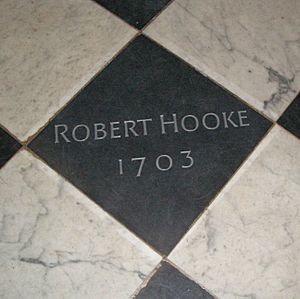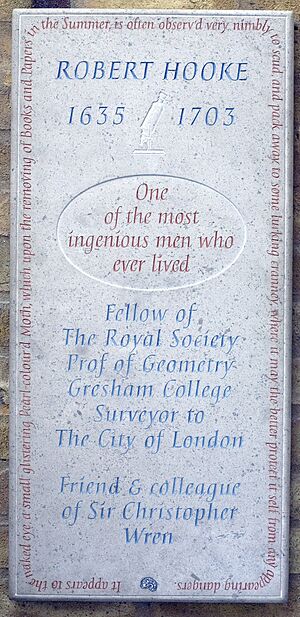List of new memorials to Robert Hooke 2005–2009 facts for kids
Robert Hooke was a very important scientist and inventor from the 1600s in England. When he died, he didn't have any special memorials to remember him. This was partly because he didn't have close family and had some disagreements with other scientists.
But many years later, in 2003, people decided it was time to honor him. They started working to create memorials for Hooke in important places.
A Special Spot in Westminster Abbey
A man named Eddie Smith worked very hard to get a small memorial for Robert Hooke in Westminster Abbey. Hooke used to go to school there. It took many years, but in 2005, a memorial was finally put in place.
The memorial is a simple carving in the black marble floor. It says "Robert Hooke 1703". You can find it near the pulpit, under the main dome. This spot is perfect because Hooke himself helped design and lay this very floor!
Honoring Hooke at The Monument
There's a famous tall pillar in London called "The Monument". It was built to remember the terrible Great Fire of London in 1666. For a long time, people thought only Sir Christopher Wren designed it. Because of this, Robert Hooke's name was not on it.
However, Hooke played a big part in designing The Monument too! So, a new carving was added to the paving nearby. This new stone carving makes sure everyone knows about Hooke's important role.
The stone is quite large and was brought all the way from Caithness in Scotland. It was then carved in London. You can see it easily from the entrance of the Monument Underground Station. Many tourist tours now include it as a special stop. The words on this memorial were written by Dr. Allan Chapman.
Remembering Hooke at St. Paul's Cathedral
Another memorial for Robert Hooke is in St. Paul's Cathedral. It's in the crypt, which is a quiet, underground area. It's placed right next to the tomb of Sir Christopher Wren.
Around the edge of Hooke's memorial, there's a quote from his amazing book, Micrographia. He published this book in 1665. At the bottom of the memorial, there's a cool metal bookworm design. It's made of brass and chrome and is set into the stone.
Because the crypt can be a bit dark, a light-colored stone was chosen for the memorial. The carved letters were painted with blue and brownish-red colors. This makes them much easier to read. The Dean of St. Paul's officially dedicated the memorial after a special evening service.




